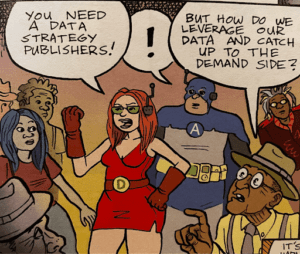Using data to try to predict the future is fine. Marketers do it all the time. But some events you can’t predict.
The pandemic, anyone?
“Sometimes data is about forecasting, but mostly it’s to create the capacity to respond … to make sure that we can go through any crisis and keep building or maintaining our business,” said François-Xavier Pierrel, group chief data officer at JCDecaux, speaking at Web Summit in Lisbon this week.
JCDecaux is one of the largest out-of-home (OOH) advertising companies in the world, operating nearly one billion billboards in more than 80 countries.
And if any category knows what it’s like to be rocked by unforeseen events, it’s the out-of-home industry.
Although out-of-home advertising budgets are back to 2019 levels, according to the Out of Home Advertising Association of America, OOH advertising fell off a cliff during the pandemic.
Wind back the clock to mid-2019, when the pandemic wasn’t yet a twinkle (or part of anyone’s predictive models). At that time, OOH was projected to grow faster than any other form of traditional media, based on numbers from MAGNA.
It was just a few months later that COVID-19 changed the world, and best-laid plans went straight out the window.
Gotta stay flex
But not all unexpected situations are “negative,” Pierrel said. Sometimes, the unexpected can present a big opportunity – as long as advertisers are able to react with agility.
Say Beyoncé wakes up one morning and decides to post a picture of herself on Instagram wearing a pair of glasses. It’s not going to take long for the company that manufacturers those glasses to be bombarded with comments, questions and new orders.
That opportunity could quickly sour if the brand doesn’t have a cross-functional structure in place to share data, act on insights in real time and meet the jump in demand, Pierrel said.
“We want people to understand that with access to data they can achieve whatever they want, whether they’re sales, marketing, corporate, legal or HR,” he said. “It’s key that the whole organization understands this.”
Portal partners
To react to and deal with unexpected situations on the fly, brands and media owners need a flexible, decentralized approach to data combined with easy-to-use tools, Pierrel said.
JCDecaux has a homegrown portfolio of global and local data solutions, including for media planning and measurement.
But JCDecaux also recently struck a partnership with alcohol company Pernod Ricard, parent company of Jameson, Absolut and Beefeater Gin, to co-develop a solution called Data Portal that centralizes data in a cloud platform to make it easier to query and take action on.
The tool, which rolled out in September, is based on technology that was originally developed in 2015 by Pernod Ricard’s IT Data Center of Excellence team.
Initially, JCDecaux wanted to buy the technology from Pernod Ricard outright. But, over lunch in 2020, executives from the two companies decided it would make more sense to collaborate.
But this isn’t a clean room situation. Although the two companies are partnering to expand the platform and they have a joint product road map, JCDecaux and Pernod Ricard aren’t sharing or exchanging first-party data, only developer resources.
The idea is they’ll be able to build the technology they need faster together (as in, the more engineers the better) and save money in the process. It takes a lot of time, cash and development work to maintain a platform, so why not share the development burden?
The partnership works because Pernod Ricard and JCDecaux aren’t competitors. The plan is to eventually sign up other noncompetitive companies to use and help co-construct the platform on an ongoing basis.
This is the first “alliance” of its type, Pierrel said.
“Now that we have this portal,” he said, “we can access data from whatever markets we need.”













